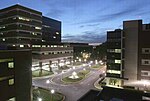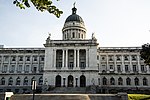Essex Street station (NJ Transit)

Essex Street, known as Hackensack during the Erie Railroad era, is a New Jersey Transit rail station on the Pascack Valley Line, located in Hackensack, New Jersey, at 160 John Street. The Pascack Valley Line services this station seven days a week. The first station house was built in 1861 by the Hackensack and New York Railroad on a track extension from Passaic Street in Hackensack. The station was turned over to the Erie Railroad in 1896, serving as a partial headquarters before being moved to Hillsdale and New Jersey Transit in 1983. The station was once the southernmost of four stations in Hackensack, which included stations at Anderson Street, Fairmount Avenue, and Central Avenue.
Excerpt from the Wikipedia article Essex Street station (NJ Transit) (License: CC BY-SA 3.0, Authors, Images).Essex Street station (NJ Transit)
East Railroad Avenue,
Geographical coordinates (GPS) Address Nearby Places Show on map
Geographical coordinates (GPS)
| Latitude | Longitude |
|---|---|
| N 40.87934 ° | E -74.051579 ° |
Address
East Railroad Avenue
East Railroad Avenue
07601
New Jersey, United States
Open on Google Maps







